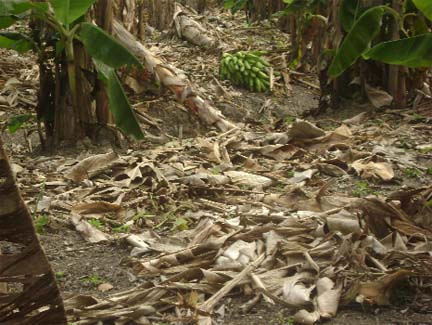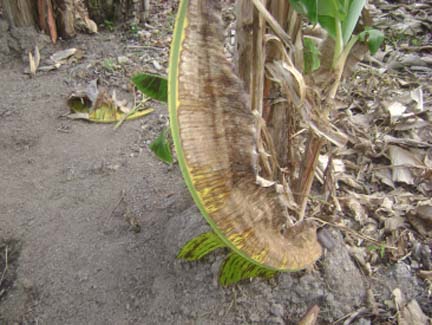A Black Sigatoka infection is threatening the local banana and plantain industries and farmers in the Tuschen area are already counting their losses as the disease has destroyed several acres of plantain trees.

Stabroek News visited farms aback the Tuschen Housing Scheme on Thursday, where several farmers explained the impact the disease has had on a vast expanse of plantain farms.
According to the farmers in the area, many of whom cultivate plantains, the disease was first observed on their farms late 2008 but at the time many of them could not determine what was causing their plants to die. They said that they were referring to the disease as “the dry leaf disease,” but it was only after they were provided with technical information by persons within the agriculture sector, whom they chose not to name, that they were informed about the source of their troubles.
The farmers, who spoke to Stabroek News yesterday, also wanted their names to be withheld for fear of victimisation. They are of the opinion that the plantain industry will soon be a thing of the past. According to them, although they have invested a tremendous amount of time and money on their farms over the years, they are not reaping the benefits because of the disease.

One farmer explained that there are several stages which he has to follow when farming and these include weeding the land, placing the grass in heaps, and burning before actually planting the plantain stalks into the earth. This entire process, he stated, costs over $20,000 per an acre.
At the Rosanante Co-op Society farmlands, several acres of plantain trees lay on the ground while some which were only recently infected with the disease stood on their stalks.
The plantain trees on one person’s farm were at nine-months yesterday and, according to the farmer, he lost the entire crop. He took Stabroek News through his entire field of plantain trees, many of which lay on the ground.
He recalled that some two years ago, he observed that the colour of the leaves on his plantain trees began to change from green to a “yellowish” colour. He said he started to cut off the affected leaves but he soon observed that after the plants reached a mature stage, between eight and nine months, their leaves would “dry–up” and the plant stalk would eventually “bend in half,” even with small bunches of plantain attached.
He said that after a while he observed that the plants would eventually fall to the ground and, according to him, this existed on over five acres of his first crop. He said that he continued to plant the staple plant on another section of his farm covering more than five acres and he observed that that crop also suffered at the hands of the disease. He said that he soon concluded that he was going to lose the entire crop as a result. He said after he became aware of Black Sigatoka, he spent huge sums of money on chemicals to attack the plant disease; the main chemical being Bellis. But, according to him, the chemical had no great impact on his plants.
Farmers within the farm society have begun to diversify their crops, with one farmer noting that he has rooted out several acres of affected plantain trees and replaced them with cassava plants. He said that he knows for sure he will benefit from that crop, since no disease affecting that plant is known to be on these shores as yet.
He and the other farmers also noted that many persons who depend on farming for their livelihood were driven from the area because of the disease. They also said that agriculture officers have visited the area to assess the existence of the disease on their farms.
Some farmers sell their produce in the Parika/Tuschen area while a few market their crops to wholesale buyers who travel to the city to sell.
Proactive
PNCR-1G parliamentarian Mervyn Williams, who has been following the issue, told Stabroek News recently that the Ministry of Agriculture needs to be more proactive in its response to the plant infection. He said that the authorities should examine the needs of the plantain industry, address those and provide additional technical and financial support to the farmers concerned.
Stabroek News understands that the disease has been affecting farms at several areas across the country, including farms at Parika, Hog Island and other Essequibo Islands, including Hamburg Island, where the disease is said to be prevalent. This newspaper also understands that aspects of the yeast disease were also observed in the Waini area in Region One sometime in 2005.
The Ministry, in a notice published in Monday’s issue of the Stabroek News, stated that extension officers have been deployed to the administrative regions across the country and a unit has since been set up to focus on the Black Sigatoka disease. The disease was named for its similarities to the Yellow Sigatoka (another plant disease affecting the Musa specie (plantain and banana)) whose name was derived from the Sigatoka Valley in Fiji Islands in the Pacific after an outbreak of the disease reached endemic proportions between 1912 and 1923.
The Ministry hotline numbers remain open to the public and farmers concerned can contact the Musa Disease Management Unit (MDMU) on telephone numbers 220-2249 or 220-2842.




